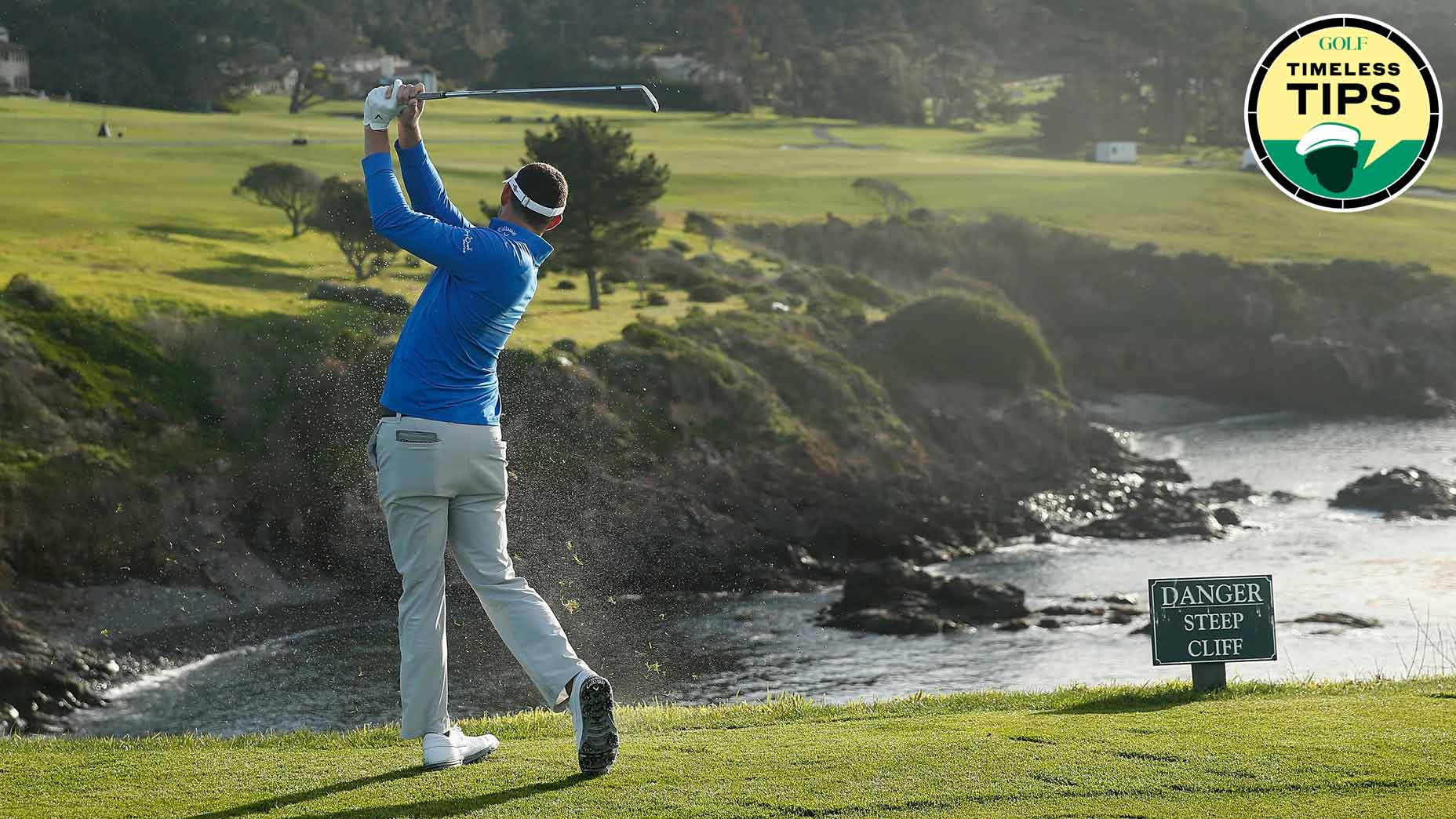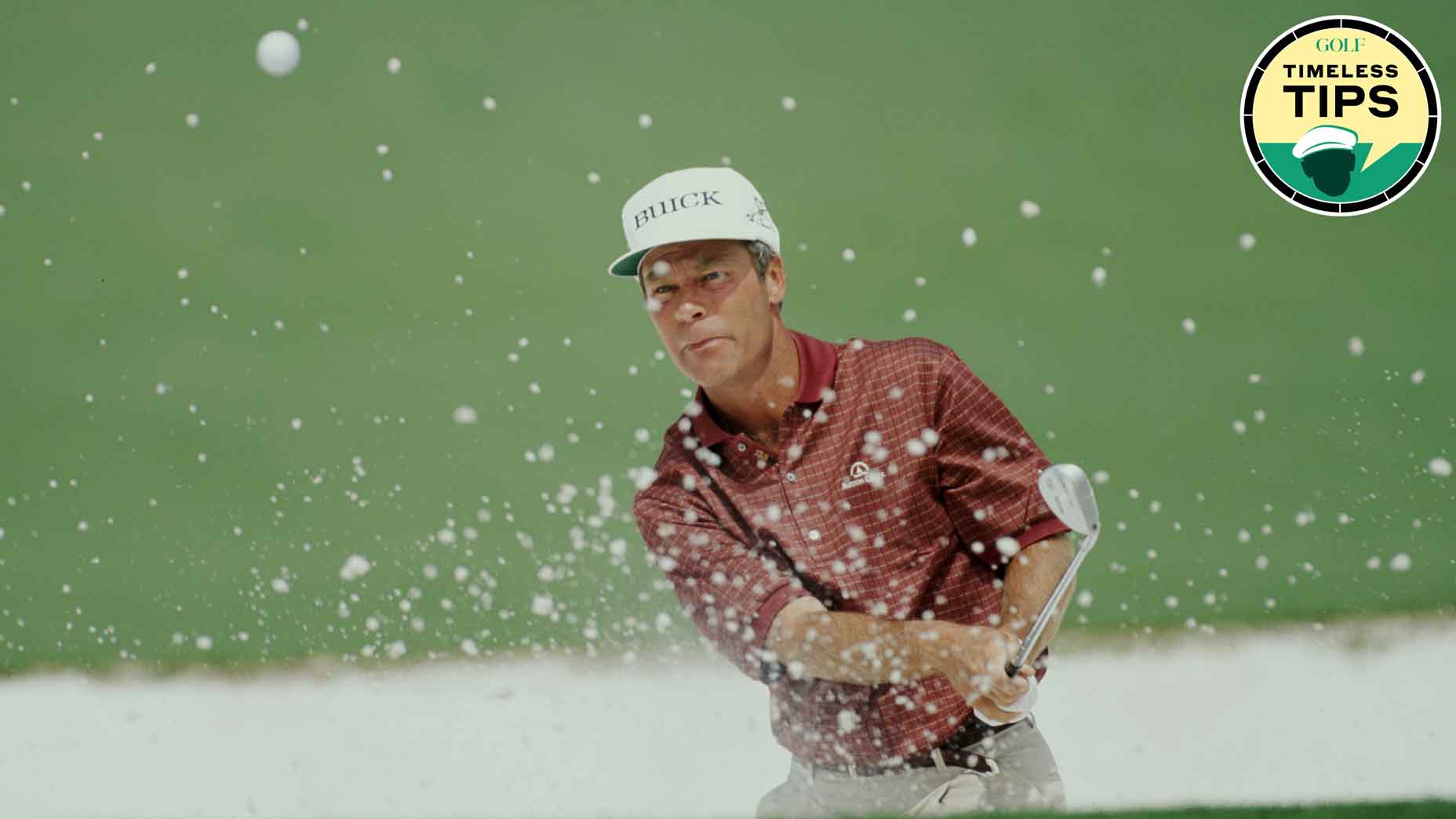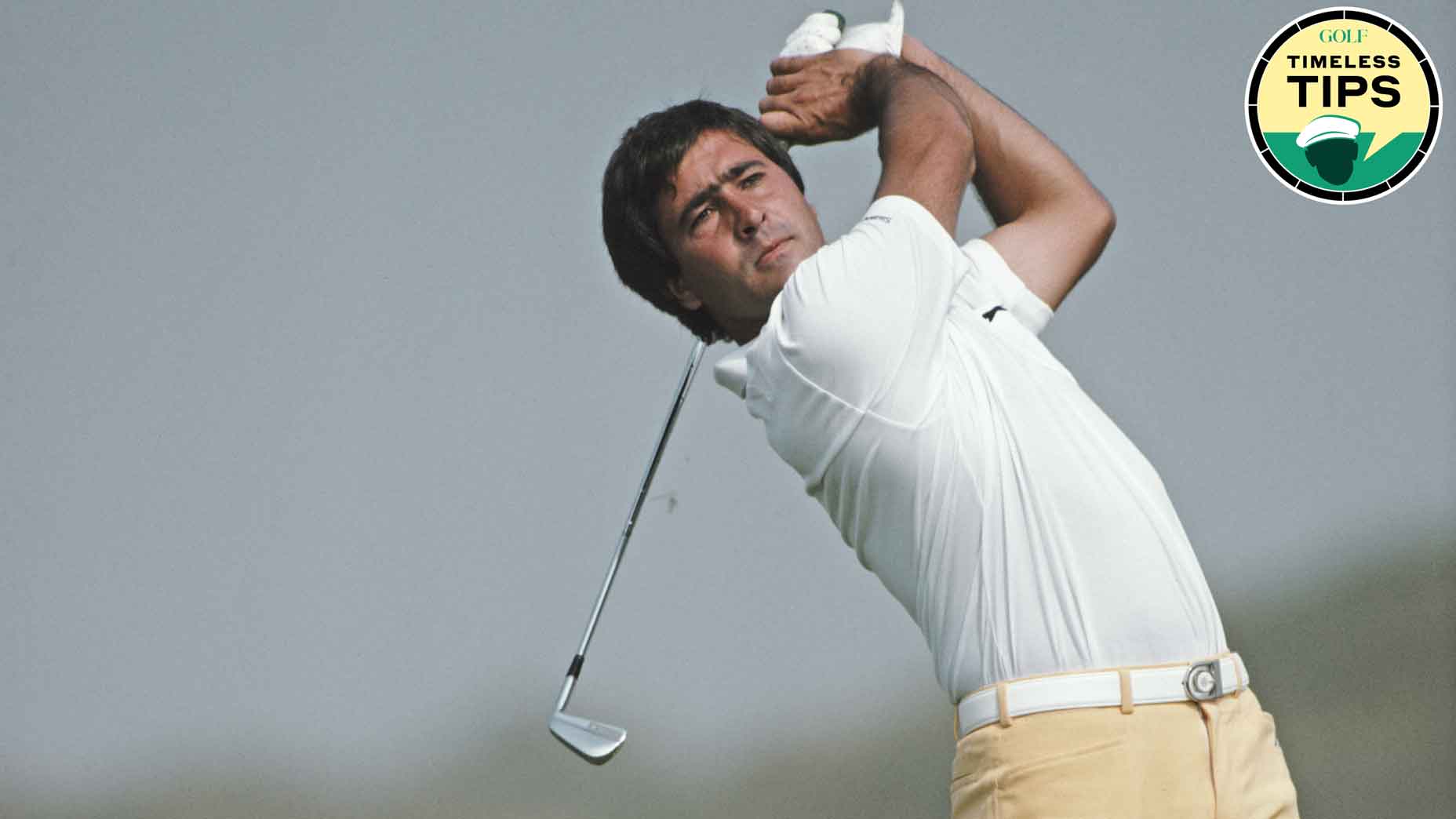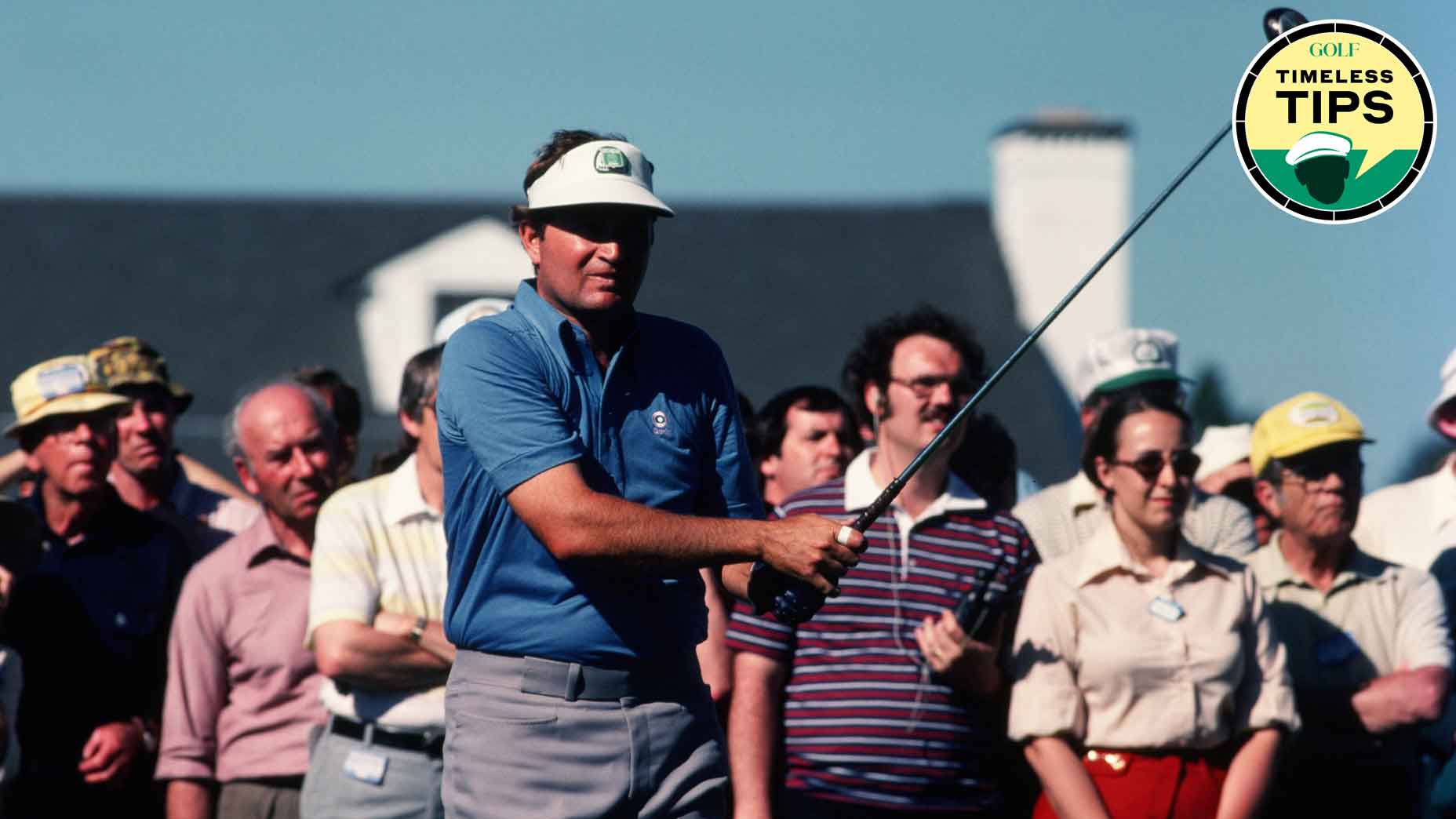The 7 scariest shots in golf — and how to conquer them like the pros
- Share on Facebook
- Share on Twitter
- Share by Email

Some shots will strike fear into even the best players in the world.
Getty Images
Golf instruction is ever-evolving, but the best advice stands the test of time. In GOLF.com’s new series, Timeless Tips, we’re highlighting some of the greatest advice teachers and players have dispensed in the pages of GOLF Magazine. This week, we take a look at some of the scariest shots in golf from our August 2002 issue. For unlimited access to the full GOLF Magazine digital archive, join InsideGOLF today; you’ll enjoy $140 of value for only $39.99/year.
Everyone gets nervous on the golf course at one point or another. The game is full of shots that will get your palms sweaty and your heart rate up. The difference between the good players and the great ones is the ability to conquer this fear when it pops up.
As any good golfer knows, though, no two shots are created equal. Depending on a variety of factors — skill, lie, stakes, etc. — each shot affects us in different ways.
Some shots are difficult in the best of circumstances — and they tend to strike fear into even the best players. Below, we revisit a rundown of the seven scariest shots in golf — with advice on how to hit them — from Jim Flick and Dr. Richard Coop featured in our August 2002 issue.
7 scariest shots in golf
Fear is everywhere in golf. Whether your bugaboo is the first tee, the pond on No. 6, or those short putts you know you should make, there’s not a golfer on earth who doesn’t feel your pain. It’s tough to pull the trigger when you don’t know what’s going to happen — or worse, when you do know, and it isn’t pretty.
First, understand that preparation is the best security blanket. When facing a shot that gives you the willies, you’d better have a technique you trust in your back pocket. And even if you do, you need a method of shooing away those demons that are sure to pop up. It’s part physical, part mental, which is why we’re both talking to you in the same article.
Below is our take on golf’s seven scariest shots. Some are scary for being just plain hard, like the pitch over a bunker; others are tough due to the setting, such as that daunting first tee shot. We’ve divided up our advice accordingly — heavy on swing tips for the tough shots, heavy on the mental for the brainteasers. So read on, and fear not.
1. Pitch over deep bunker
Flick: Your first priority should be to fly the ball over the bunker and safely onto the green. If it finishes close to the hole, that’s a bonus. Always use a lob or sand wedge, but let the lie dictate how you play this shot. From the rough, the club’s angle of approach needs to be | steeper. To achieve this, adjust your set-up: Position your head slightly ahead of the ball, with your weight favoring the left side, and open the clubface. Keep the face pointing to the sky after | impact, letting the club’s loft send the ball high.
Coop: Before anything else, walk up to the edge of the green and take a good look at the shot. It’s often easier than it | appears from the ball, and realizing that can alleviate some tension. When you return to the ball, visualization becomes key. Make some rehearsal swings, trying to match what you feel in your swing to the ball flight you see in your mind’s eye. Then, step up and reproduce these good feelings before any fear can creep in.
2. Half wedge
Flick: Why do amateurs hit the green from this range — 40 to 60 yards — only one in three times? Because after swinging full out, they suddenly have to slow everything down, which is hard to do. The trick is to match your body turn to the slower speed and shorter arc of the club. Your body and arms need freedom of motion to mesh. At address, bend from the hips and stand a little taller than normal, with a slight knee flex and your weight on the balls of your feet, giving your arms plenty of room to swing. Think of it as a long, flowing pitch rather than a half shot. The key is developing a feel for the appropriate swing length.
Coop: For most golfers, half-wedge territory is rife with bad memories. To combat them, you need some successes in your mental library, and that comes from learning good technique (see Jim’s advice) and seeing it work in practice. On the course, since you probably struggle with finding the right swing speed, use my Goldilocks Method. Take practice swings and assess each one: Is it too fast, too slow, or just right? When you make one that’s just right, step up to the ball and go.
3. Opening tee shot
Flick: Play the shot that gives you the best chance to hit the fairway. As you warm up, note the pattern your shots are naturally taking (fade or draw) and plan for it on the first tee. Or if you’re short on time, hit some chips or putts just before heading to the tee; this will get you more target-oriented. Finally, select a club, such as a 3-wood, that gets you thinking about accuracy rather than distance, and concentrate on staying behind the ball until well past impact.
Conquer first-tee jitters with this top instructor’s pre-shot adviceBy: Jessica Marksbury
Coop: Not only is it the first crack of the day, but there’s a gallery looking on, your back aches, you sat in traffic, you haven’t played in weeks — you get the picture. Having all these excuses might feel good, but you’re only talking yourself out of the shot. Instead, remember that this shot counts no more than a one-inch tap-in later in the round. Even so, you need to take care. If you’ve just hurried to the tee, step to the side and take a few slow swings with your eyes closed, emphasizing rhythm and tempo. Hum quietly while you do this; if the volume and tone stay consistent, you’re swinging smoothly. Then go through your entire pre-shot routine, taking no more or less time than you normally do. If all else fails, a few deep breaths and a positive outlook go a long way.
4. Long bunker shot
Flick: If you try to hit this shot by squaring up the face of a sand wedge and taking a longer swing, your chances for success are slim to none. Instead, apply the same principles used in a greenside bunker, with a few minor changes. Using a pitching wedge or 9-iron, position the ball slightly forward in your stance and open the clubface at address to take advantage of the club’s bounce. Feel like you’re swinging more around your body, which lets the club glide through the sand. Remember to follow through, and the ball should fly out with a medium to high trajectory.
Coop: Considered by many the hardest shot in golf, this one can make any golfer feel a bit squeamish. The trick is having a positive sensory cue to latch onto, because your mind will tend to wander into the negative. Try to identify a strong image or sensation that has worked for you in the past. Sometimes it only takes one good sensory experience to turn your dread over a shot into excitement. Examples include splashing the sand halfway to the hole or hearing the “thump” of the clubhead through the sand. When you get one that works, file it away — you’ll need it.
5. Downhill slider
Flick: First, decide the speed you want to | hit the putt, as that will determine the line. Then make a couple of rehearsal strokes that match that speed, visualizing the ball’s roll. Keep your grip pressure light, and if the green is really slick, grip down an inch or two to shorten the arc. I don’t recommend hitting the ball off the toe of the putter — while it does slow the putt, it leads to poor direction | control. Doing this means you may have subconsciously given up trying to make it.
Coop: The problem with this shot is that it looks too easy. If you miss, you know you’ll be kicking yourself. Avoid such negative predictions by focusing on your normal pre-putt routine. Make a practice stroke or two. Pick a spot to roll the ball over or envision a stripe to the hole. In short, don’t dismiss these putts as | no-brainers; your track record proves they’re not. Another common problem is trying to guide or steer the ball to the hole. To combat this, set your stance so the distance between your feet matches the length of stroke you want. Then, play the ball in the middle and swing back | to your right foot and through | to your left. This guards against the abbreviated | through-stroke that results from steering or guiding.
6. Shot following a shank
Flick: Repeat after me: A shank is not caused by an open clubface. That’s a big misconception. A shank happens when the hosel of the club strikes the ball due to an extreme out-to-in swing path. To avoid another one, focus on hitting the inside of the ball. Drop your right foot back from your stance line to help you make a full backswing turn and get completely behind the ball. Your hips will stay closed, which helps the club approach the ball from the inside.
Coop: There you are playing along nicely when, suddenly, one jumps up and bites you. It’s a “shank attack,” and you stand there startled like a deer in headlights, wondering what’s going on. That’s when you need to know how not to shank, which Jim describes above. You also need to take a mental time-out. Perform a simple ritual, such as rubbing your grip with a towel or untying and retying your shoes, that gets your brain momentarily working on something else. These little tasks make you disengage and then refocus. Come back with a simple and positive mindset. There’s no reason the shanks shouldn’t go away as quickly as they showed up.
7. Approach over water
Flick: It is critical here to locate the bottom of your swing arc. Take a “L few rehearsal swings and note where the club brushes the Qrass; this is where you should play the ball. If you’re really nervous, grip down about an inch: A slightly thin shot might still carry the water, but a fat shot definitely won’t. The tendency when you’re nervous is to make a short, quick swing. That’s why you must grip the club lightly and relax your arms at address. Then, make a complete backswing. This will promote a smooth, accelerating motion through the ball.
Coop: This shot comes with the fear of actually losing a ball. This may sound minor, but it’s the ultimate in finality. To ease the pressure, don’t let yourself get caught up in the scene. Pick an intermediate target a few feet in front of the ball and make your last look at that spot. Be careful not to look at the water, because every time you do, you get a fresh dose of fear. Instead, get engrossed in the process of trying to hit your best shot.
Latest In Instruction

Zephyr Melton
Golf.com Editor
Zephyr Melton is an assistant editor for GOLF.com where he spends his days blogging, producing and editing. Prior to joining the team at GOLF, he attended the University of Texas followed by stops with the Texas Golf Association, Team USA, the Green Bay Packers and the PGA Tour. He assists on all things instruction and covers amateur and women’s golf. He can be reached at zephyr_melton@golf.com.










